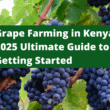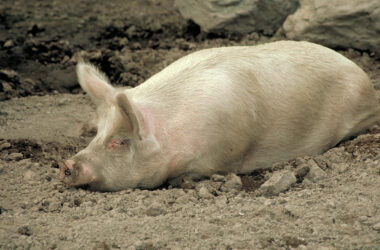Why Turkey Farming Could Be Your Next Big Move
Looking for a poultry venture that breaks away from the usual chicken farming crowd? Turkey farming in Kenya might just be your ticket to impressive profits and a market that’s barely been tapped. Unlike the saturated chicken business, turkey farming offers significantly higher returns while requiring similar expertise – talk about a smart pivot.
If you’re new to farming or looking to diversify, you’re in the right place. Kenya’s agricultural landscape is ripe for turkey farming ventures, with demand growing steadily and competition still relatively low. The best part? You don’t need a fortune to get started.
This guide walks you through everything you need to know about starting a successful turkey farming business in Kenya – from choosing the right breeds to maximizing your profits. Let’s dive into why this underexplored venture deserves your attention.
Current State of Turkey Farming in Kenya: A Market With Room to Grow
Turkey farming in Kenya remains surprisingly underdeveloped despite its profit potential. Most operations are concentrated in urban areas, with free-range systems being the most popular approach. The poultry sector, including turkey farming, contributes about 1.7% to Kenya’s GDP – a figure that shows both its current importance and room for growth.
What makes the turkey market particularly interesting is the seasonal demand spike. During festive seasons, especially Christmas, the demand for turkey meat skyrockets. For context, the UK alone consumes over 10 million turkeys during Christmas season. This seasonal opportunity creates a lucrative window for Kenyan farmers who plan their production cycles strategically.
The breeding landscape in Kenya has significant gaps. The country has a low population of parent stock and no pedigrees, with most hybrid parent stocks being imported from Western countries. Local breeders typically produce commercial birds through natural incubation – less efficient than modern methods but creating an opportunity for farmers willing to invest in improved techniques.
Why Turkey Farming Beats Chicken Farming: The Numbers Don’t Lie
Wondering if turkeys are really worth the switch from chickens? Here’s why turkey farming is gaining traction among smart farmers:
Higher Profit Margins
One turkey can earn you what ten chickens would. Let that sink in. Farmers can earn three to four times more income from turkeys compared to chickens over a six-month period. When you consider the space, feed, and management requirements, turkeys often provide better returns on investment.
Multiple Income Streams
Turkeys aren’t just about meat. You can sell eggs (which fetch prices comparable to a whole tray of chicken eggs), breeding stock, and even exhibit your birds at agricultural shows. This diversification helps smooth out income throughout the year.
Growing Market Demand
As Kenyan consumers become more health-conscious and open to diverse protein sources, turkey meat is finding its way onto more plates. The meat is leaner than chicken and has a distinctive flavor that’s gaining appreciation among middle and upper-class consumers.
Low Entry Barrier
You can start small with as little as Ksh 10,000. While a more substantial investment gives you better footing, the option to start small and scale gradually makes turkey farming accessible to farmers with limited capital.
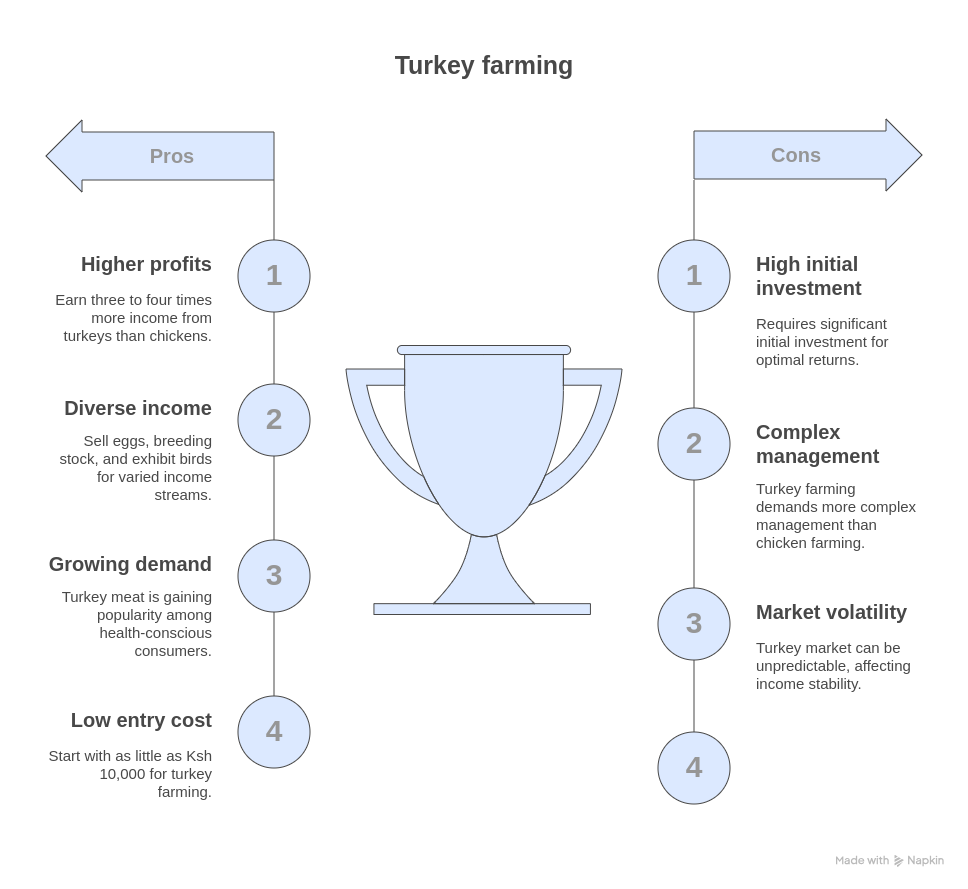
Choosing Your Turkey Breeds: What Works Best in Kenya
Selecting the right breed is crucial for your success. Here are the top performers in Kenya’s climate and market conditions:
White Holland
Characterized by wide breasts and short legs, these birds are meaty and perfect for commercial meat production. Some hens show broody behavior, which can be beneficial if you’re planning natural reproduction.
Black Turkey
These common birds adapt well to local conditions and are fairly resilient. They’re a good choice for farmers just getting started who want birds that can handle Kenya’s diverse climate zones.
Beltsville White
A smaller breed that still offers profitable returns. Their smaller size makes them perfect for families looking for smaller portions, potentially opening up a niche market segment.
B.U.T and Broad Breasted White
These are fast-growing breeds suited for commercial meat production. B.U.T. turkeys can reach impressive weights of up to 22 kilograms by 23 weeks of age, making them ideal if you’re focusing on maximum meat production.
Broad Breasted Bronze
These larger birds adapt well to both free-range and confined systems. They’re visually striking and grow to substantial sizes, making them good dual-purpose birds for meat and exhibition.
Local Kienyeji Turkeys
If you’re looking for resilience, local Kienyeji turkeys are better adapted to Kenyan climatic conditions than imported breeds. They may grow more slowly but often require less intensive management.
Breed Selection Tips for Beginners
When starting out, prioritize:
- Breeds that handle local climate conditions well
- Birds with good growth rates
- Breeds that match your target market (holiday meat vs. year-round sales)
- Disease resistance, especially if you’re planning a free-range system
Housing Requirements: Setting Your Turkeys Up For Success
Proper housing significantly impacts your turkeys’ health, growth rate, and ultimately your profits. Here’s what you need to know:
Space Requirements
Turkeys need substantially more space than chickens – about 45 square feet per bird in enclosed housing. For free-range systems, allocate 10-12 square feet of outdoor space per bird. Crowding leads to stress, reduced growth, and increased disease risk.
Housing Design Essentials
Your turkey house should feature:
- Good ventilation to prevent respiratory issues
- Predator-proof construction
- Sufficient perches and roosting spaces (turkeys prefer to roost off the ground)
- Protection from extreme weather conditions
Flooring Considerations
Deep litter material such as sawdust or straw works best for turkey housing. Maintain a dry litter bed by regularly turning it and replacing soiled sections. Wet litter leads to foot problems and disease outbreaks.
Brooding Setup
Young turkeys (poults) require special care during their first six weeks. Rear them in brood rings with:
- Controlled temperature (starting at about 35°C and gradually decreasing)
- Protection from drafts
- Access to clean water and specialized starter feed
- Gentle handling to prevent stress
Growth Cycle and Timeline: Planning Your Production
Understanding the turkey growth cycle helps you plan feeding programs, housing transitions, and market timing:
Incubation Period
Turkey eggs require 28 days of incubation before hatching. You can use natural incubation (broody hens) or artificial incubators. The latter offers more control and efficiency for commercial operations.
Brooding Phase
Poults remain in brood rings for their first six weeks of life. This period requires the most intense management and vigilance against diseases. Mortality rates are typically highest during this phase.
Growing Phase
After six weeks, transfer birds to grow-out accommodation until they reach market weight. This is when you’ll see the most dramatic growth, especially in breeds selected for meat production.
Market Timeline
- Female turkeys (hens): Generally ready for slaughter at 12-14 weeks, weighing approximately 5.5 kilograms
- Male turkeys (toms/gobblers): Typically slaughtered at 18-21 weeks, weighing between 14-17 kilograms
- Some farmers keep male turkeys until 10 months, reaching weights up to 10 kilograms
This staggered growth pattern allows you to plan harvests based on market demand and price fluctuations.
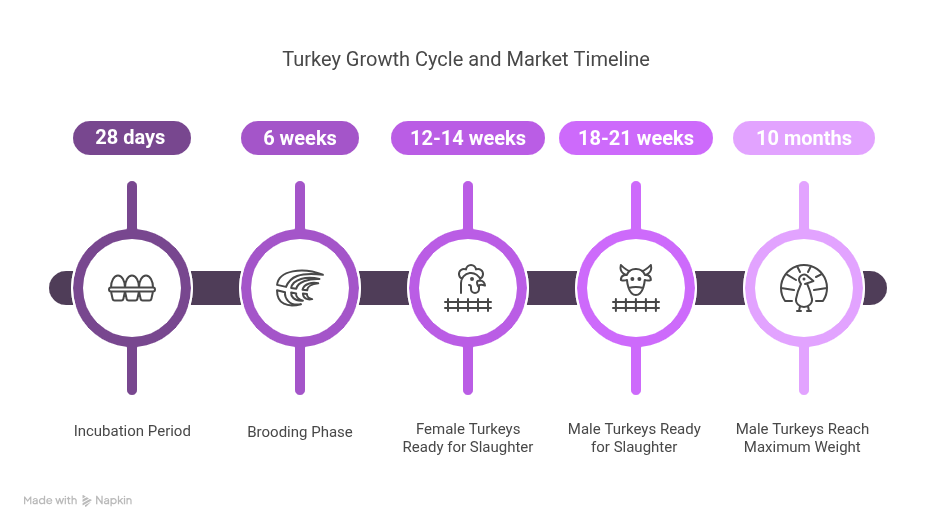
Feeding Your Flock: The Key to Healthy Growth
Feed represents 40-70% of your production costs, so getting this right impacts your bottom line significantly:
Feed Formulations by Growth Stage
| Growth Stage | Age Range | Protein Content | Key Features |
|---|---|---|---|
| Starter Feed | 0-8 weeks | 28% | High protein for rapid early growth |
| Grower Feed | 8-16 weeks | 20-24% | Balanced nutrition for continued development |
| Finisher Feed | 16+ weeks | 16-18% | Lower protein, preparation for market |
Feed Consumption Metrics
Each turkey typically consumes about 40-50 kilograms of feed from day one until market weight at six months. With current pricing of approximately Ksh 1,100 for 20 kilograms of commercial feed, feed costs require careful budgeting.
Cost-Saving Feeding Strategies
- Implement free-range systems where birds can forage for some nutrition
- Provide green vegetation as supplementary feed
- Consider mixing your own feed if you have the knowledge and resources
- Buy feed in bulk during price dips if you have proper storage
Health Management: Preventing and Addressing Disease
Disease outbreaks can devastate your turkey farming business. Here’s how to keep your flock healthy:
Critical Vulnerable Period
Young poults (2-6 weeks) are particularly susceptible to non-specific gastrointestinal infections that cause diarrhea, wet litter, uneven development, and poor feed conversion. This period requires heightened vigilance.
Common Turkey Diseases
Gut health issues are typically caused by cocci, bacteria, and viruses, often made worse by stressors like starvation, chilling, and poor ventilation. Turkeys are also susceptible to Newcastle disease and Fowl Pox, similar to chickens.
Preventive Measures
- Implement strict biosecurity protocols
- Maintain clean, dry housing with proper ventilation
- Follow a comprehensive vaccination schedule
- Quarantine new birds before introducing them to your flock
- Provide balanced nutrition and clean water
Treatment Approaches
When disease strikes, consult a veterinarian for proper diagnosis. Management typically includes appropriate antibiotics following laboratory sensitivity tests to ensure effectiveness.
Financial Breakdown: What to Expect
Understanding the economics of turkey farming helps set realistic expectations:
Revenue Potential
Individual turkeys sell for between Ksh 12,000 and 16,000, with pricing typically based on weight at approximately Ksh 800 per kilogram. This represents a significant premium over chicken prices.
Cost Structure
- Initial stock: Poults cost between Ksh 800-1,500 depending on breed and source
- Feed: Your largest expense at 40-70% of total costs
- Housing: One-time investment with ongoing maintenance
- Healthcare: Vaccines, medications, and occasional veterinary services
- Labor: Depends on your farm size and level of automation
Return on Investment Timeline
With proper management, turkey farming can become profitable within the first production cycle, especially when targeting high-value markets during festive seasons.
Success Stories: Real Kenyan Farmers Making It Work
These success stories demonstrate the potential of turkey farming in Kenya:
Bernard Osunga’s Rapid Growth
After losing his construction job during the COVID-19 pandemic, Osunga started turkey farming in 2021 with just four birds. Within two years, he expanded to 207 turkeys on his one-acre farm in Migori County, selling over 73 birds and generating approximately Ksh 800,000 in income. His story shows how quickly a small operation can scale with proper management.
Chore Sunda’s Long-Term Success
Engaged in free-range turkey farming since 1984, Sunda has sustained his family through this enterprise, generating enough income to pay school fees for his two sons from secondary school through middle-level colleges. His experience demonstrates the long-term sustainability of turkey farming as a primary income source.
Challenges You’ll Face and How to Overcome Them
Being prepared for challenges increases your chances of success:
Limited Breeding Infrastructure
The challenge: Kenya has a low population of parent stock and relies heavily on imported hybrid parent stocks. The solution: Network with established breeders, consider hatching your own replacement stock once established, or partner with other farmers to share breeding resources.
Disease Management Complexities
The challenge: Young poults are particularly vulnerable to diseases. The solution: Implement strict biosecurity measures, follow vaccination protocols, and invest in proper housing and nutrition to boost natural immunity.
High Feed Costs
The challenge: Feed represents 40-70% of production costs, with prices subject to market fluctuations. The solution: Consider partial free-range systems, grow some feed ingredients if possible, and buy in bulk during price dips.
Knowledge Gaps
The challenge: Many new farmers lack specific knowledge about turkey rearing. The solution: Connect with agricultural extension officers, join poultry farming associations, and utilize online resources dedicated to turkey farming.
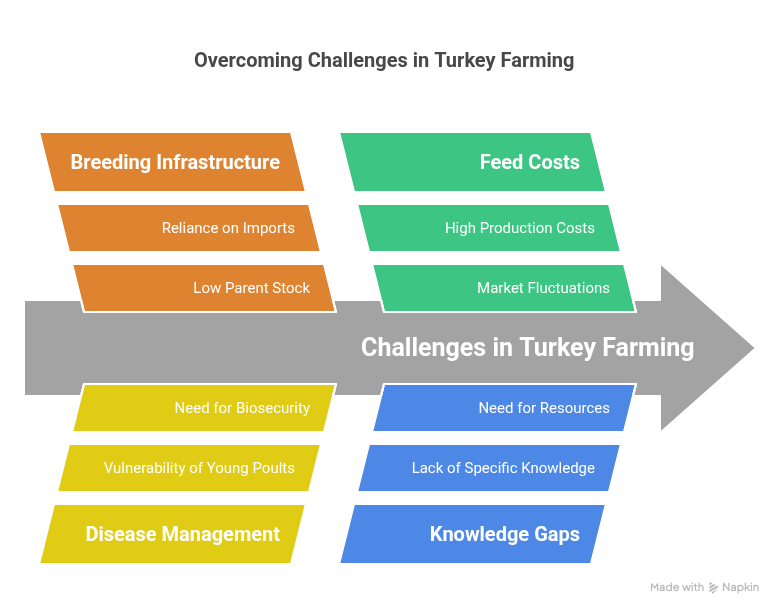
Getting Started: Your Step-by-Step Guide
Ready to jump in? Here’s how to start your turkey farming venture:
1. Start Small and Scale Gradually
Begin with a manageable number of birds (20-50) and expand as you gain experience and capital. This approach minimizes risk while you learn the ropes.
2. Research Thoroughly
Understand the specific requirements of turkey farming before investing. Visit established farms, attend agricultural shows, and connect with experienced farmers.
3. Choose Appropriate Breeds
Select breeds well-adapted to local conditions and aligned with your market goals (meat production, breeding stock, or exhibition).
4. Secure Reliable Feed Sources
Establish relationships with reputable feed suppliers to ensure consistent quality and pricing. Consider negotiating bulk discounts or joining a farmer cooperative for better prices.
5. Implement Proper Vaccination Protocols
Develop and strictly follow a comprehensive vaccination schedule to prevent disease outbreaks. Consult with a poultry veterinarian to create a schedule suited to your specific location.
6. Build Strong Market Networks
Before your birds reach market weight, establish relationships with reliable buyers. Target hotels, high-end butcheries, and event caterers who appreciate quality turkey products.
Financial Planning for Success
Proper financial planning is essential for your turkey farming venture:
Initial Investment Guide
While turkey farming can be started with as little as Ksh 10,000, a more substantial investment of Ksh 50,000-100,000 provides a stronger foundation for a small commercial operation.
Operating Capital Requirements
Set aside sufficient funds for at least six months of operating expenses, including feed, medications, and utilities. This buffer helps you weather unexpected challenges or market fluctuations.
Marketing Budget Allocation
Allocate resources for marketing activities to help establish your brand and connect with potential buyers. Even simple branding and social media presence can differentiate your products.
Expansion Planning
Reinvest a portion of profits into farm expansion, gradually increasing your flock size and infrastructure. This sustainable growth approach builds a solid business foundation.
Your Turkey Farming Journey Begins Here
Turkey farming in Kenya represents an exciting opportunity for new farmers. With relatively low capital requirements and higher returns compared to traditional poultry farming, it offers an attractive entry point into commercial agriculture.
The success stories of farmers like Bernard Osunga and Chore Sunda demonstrate that with proper management, turkey farming can provide substantial income and long-term financial stability. As consumer preferences continue to evolve and demand for diverse protein sources grows, turkey farming is well-positioned to expand in Kenya.
Ready to start your turkey farming journey? Begin with thorough research, start small, and focus on quality management. The turkey market in Kenya has plenty of room for new, dedicated farmers willing to learn and grow with this promising agricultural venture.
Have you considered turkey farming before? What aspects of this unconventional poultry business intrigue you most? Share your thoughts in the comments below!






